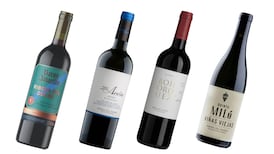T his week we veer right off the beaten track and celebrate three female authors who have each published a well-written book on an obscure wine region. Books on nebbiolo, vin jaune and Georgian qvevri wine are unlikely to climb the best-sellers lists. But each is a lovely read.
Alice Feiring was a fascinating and provocative speaker on natural wine at the Ballymaloe Litfest 2015. She has gone on to write a wonderful, emotional book, For the Love of Wine, about traditional winemaking in Georgia, one of the oldest wine-producing countries in the world. She explores the ancient culture of making wine in qvevri, clay amphorae, and meets up with some of the most remarkable characters making wines that sound intriguing.
I would love to have included the amazing Pheasant’s Tears Saperavi as a wine of the week. The wine is macerated and fermented with stems, skins and pips in clay amphorae lined with beeswax and buried in the ground for months on end. Sadly, it has sold out completely.
The Jura has been the trendiest region in the wine bars of London and New York for several years. It produces some of the most unusual and least known (until recently) wines of France. Even the most hardened wine anorak will find it difficult to recall savagnin, poulsard and trousseau.
And nowhere else in France will you find a vin jaune, the country’s answer to sherry, as well as the most extraordinary chardonnay and pinot noir. Wink Lorch, author of Jura Wine, has spent part of the year in the French Alps for two decades. Her enthusiasm and knowledge is infectious; this book really makes you want to travel there, drink the wine and eat the food too.
Jancis Robinson calls growing nebbiolo an exercise in precision engineering. In Barolo and Barbaresco: the King and Queen of Italian Wine, Kerin O’Keefe writes that, for her, barolo “was like a Fellini film; with the first sip I wasn’t quite sure what was going on but I knew I liked it, by the next sip it was starting to make sense, and by the time I finished the glass I was hooked”. Not everyone finds it so easy to love nebbiolo, which can have very high levels of tannins and acidity. It has a haunting bouquet. All are agreed that it hates to travel outside of Piedmont, and that it reaches its apogee in two small towns; Barolo and Barbaresco.
Like Feiring, O’Keefe pulls no punches, and is quite happy to criticise where she feels it is required. She has an obvious love and understanding of her subject. Her book is the definitive guide to the soils, the grapes and the growers producing these great wines.












